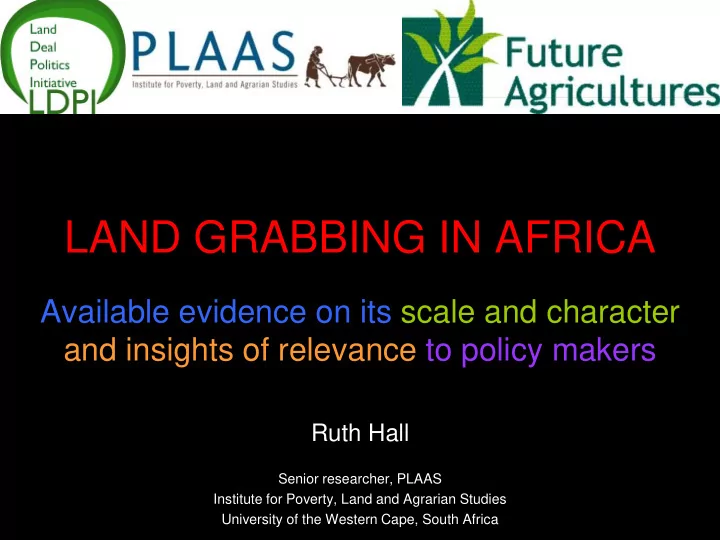

LAND GRABBING IN AFRICA Available evidence on its scale and character and insights of relevance to policy makers Ruth Hall Senior researcher, PLAAS Institute for Poverty, Land and Agrarian Studies University of the Western Cape, South Africa
Structure 1. Africa: the centre of the global rush for farmland Source: Bertolazzi, in FAO 2007 – Why? – For what? How? Where? – Impacts? 2. Key messages – Africa‟s land is not empty, idle or available – Not only land being grabbed – Investors are not necessarily the „grabbers‟ – Remedy: tenure reform & re-direction of agricultural policy
Overseas Land Investments to Secure Food Supplies 2006 – 09 Source: von Braun and Meinzen-Dick 2009, with data compiled from media reports.
Where are major land deals taking place?
Where are major land deals taking place? Large-scale land acquisitions (2009) Total approx 45 million hectares Africa Rest of the world Source: World Bank 2010
Large land deals in Africa Drivers & actors: – Asian powers seeking to secure food supply – Oil-rich (but land and water poor) Gulf States – European and North American banks, financiers and sovereign funds, responding to financial crisis – All the above in partnerships with African governments and/or domestic partners. Source: Blas (Financial Times) 2010
Why is Africa the centre of land grabbing? 1. Customary tenure unrecognised by state / investors • Dominance of customary tenure systems that are inadequately recognised in law enable • Customary use rights are inadequately recognised either in law or in practice as holders of real property rights. 2. The land is presented as unused and available • The central “Guinea - Savannah” zone of Africa constitutes a “vast under- utilised land reserve” – World Bank 2009 • But evidence that all of it is claimed, used or occupied.
„Whose land are you giving away, Mr President?‟ • Remedy lies in… legal acknowledgement that customary and other longstanding unregistered land tenancy amounts to a real property interest, registered or not… Without this change, majority rural landholders remain little better than squatters on their own land, a condition already wrongfully endured for a century or more… While hardly new, the current wave of state… backed leasing hardens an already dangerous dichotomy between the interests of governments and their people – Alden Wily 2010: 1 Source: Hall 2008
African Union framework & guidelines on land policy (2009) AFRICAN UNION • Concern about “the new scramble for Africa‟s land resources” – The first started in the 1880s after the conference of Berlin which defined colonial boundaries) – Widespread adoption of land policies and laws over past two decades – but with very limited civil society involvement, and poorly implemented. – ‘Sustainable growth and development in Africa as well the continent’s contribution to the world economy in the 21st century will continue to depend largely on the manner in which land and land- related resources are secured, used and managed’ - African Union 2009.
Land grabs for what, how, where? Dimension Range of experiences documented Size Available data on deals over 1,000 hectares; huge variation ranging up to deals of 500,000 hectares and plans of deals up to 10 million hectares Duration Short to medium term, but mostly long-term 15-25 year (often renewable) leases, and up to 50 or 99 year leases Source Domestic private investors, foreign private investors (both being individuals or large companies), parastatals, foreign sovereign wealth funds, Commodity Jatropha, sugar, rice, other foods, forestry, various minerals, also tourism experiences. Business model Enclave model, colonist model, large commercial estates, nucleus estates with outgrowers, outgrowers and processor, smallholder model Tenure arrangements Lease, concession, illegal enclosure, or purchase (rare) Resource access Land, water, minerals, marine resource, wildlife, forestry (and labour) Lease / compensation Value, method of calculation, timing (once-off or repeat, eg. annual payments) and payments distribution to local communities, traditional leaders and local, district, provincial and national government „Vacant‟ and „unused‟ land, claimed land, grazing land, cultivated lands, lands used for Displacement natural resource harvesting Labour Locally hired labour, imported labour, self-employment as outgrower Settlement Changes in settlement (eg. villagisation), de-agrarianisation Infrastructure Investment in infrastructure for production, processing transport (roads, ports), and social infrastructure (schools, clinics)
An (incomplete) depiction of major land deals in some countries of Southern Africa Jatro- Sugar Mining Cotton Rice Tourism Hydro- Fore pha electric stry Angola X X Madagascar X X X Malawi X X X Mozambique X X X X X X X Namibia X X X South Africa X X X X Tanzania X X X X Zambia X X X Zimbabwe X X X
Impacts? • Displacement: settlement, cultivation, pasture, natural resource harvesting. • Outcomes: – Projected employment effects unrealised. – Deals without investment. – Biofuels: deforestation for plantations. • Changes in social relations – conversion of small-scale farmers into wage labourers – accentuated social differentiation. • Changes in land uses: – towards monocropping – out of food crops or – out of agriculture. Source: Hall 2008
Land use changes not readily reversed Cleared forest at Bioshape jatropha Forest livelihood at Kilwa, Tanzania plantation „trial plot‟ Kilwa district (IFM report, (Sulle, undated) 2009)
Key messages „Vacant land‟ discourse fundamentally flawed and 1. untrue – no cases of deals on land that is neither claimed, used or occupied by local people already Not just land being „grabbed‟ 2. – water, minerals, forests, other natural resources… and labour Investors are not necessarily the „grabbers‟ 3. – Political economy of land and resources: state control and feasibility of appropriation of land for investment 4. Remedy lies in (i) securing customary rights to land, water and other natural resources and (ii) substantive re-direction of agricultural policy.
Recommend
More recommend